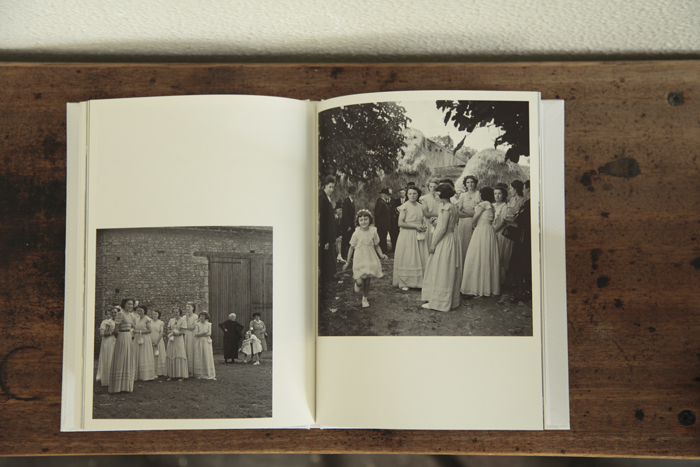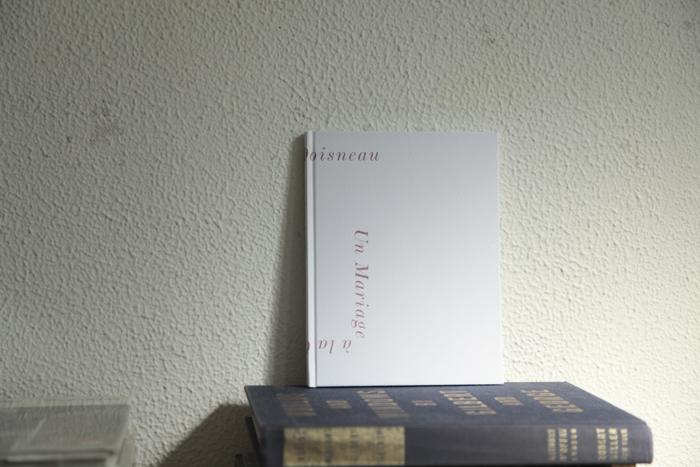本書は、フランスを代表する写真家ロベール・ドアノーが、ある村の結婚式の写した写真集です。ときは1951年。新婦が18歳で新郎は24歳。ドアノー独自の視線による饗宴のドキュメンタリーです。
ドアノーとこの村との接点は、第二次世界大戦中、ドイツ軍の侵攻から逃れるため、疎開してきたことによります。新婦の実家が、ドアノー一家の住居を提供してくれたのです。それから、およそ7年、この挙式のためにドアノーは村に戻ってきました。
掲載された写真に、自らを表現しようという写真家の情念が感じられないのは、そのためです。あるのは、誰かを喜ばせようという、仕事の意気地です。
カメラマンには、ブライダルという、れっきとした仕事の分野がありますが、見慣れたブライダル写真と比べて、本書が傑出しているのは、新郎新婦以上に、列席者の子どもやお年寄りの表情に焦点が向けられている点にあります。
ドアノーは、列席者たちの憧憬、歓喜、緊張、安堵、懐かしみといった表情を、逃すことなく写しました。まるで、列席者の表情にこそ、新郎新婦のこころが反映されていると云わんばかりに。その表情にこそ、父母の心境が代弁されていると語っているように。そして、このとこが、生きる悦びに満ちた村の空気を、しっかり私たちに伝えることにも成功しています。
ドアノーにとっては、戦争の記憶が残る場所だからこそ、平和の悦びもひとしおだったのではないでしょうか。美術史の世界では、ややもすると、表現より仕事の方が歴史に残るといわれますが、この写真もその一例になりそうです。
末尾には、エッセイストの平松洋子さんが、この写真と出会ったきっかけと、初公開されるにいたった経緯を記しています。平松洋子さんの感性がなかったら、私たちがこの写真を見ることはできませんでした。このエッセイも、ぜひ読んでおきたいです。
 PHOTOGRAPHY BY KAZUO MINATO
PHOTOGRAPHY BY KAZUO MINATO
This book is a collection of photographs taken from a wedding in a village by representative French photographer, Robert Doisneau. The time is 1951. The bride is 18 and the groom is 24. It is a documentary from the unique view of Doisneau.
Doisneau's contact with the village is due to his fleeing the invasion of the German army during the World War II. The bride's family housed the Doisneau family. Afterwards, about 7 years later, Doisneau returned to the village for the wedding. It's because of this that the photographs feel as if the photographer did not express his emotions. Those that do are because of his self-respect for the job of making someone happy.
There is the respectable field of work in bridal photography, but this collection stands out compared to the usual bridal photos because the focal point is on the expressions of those present other than the bride and groom, like the children and elderly.
Doisneau captured their adoration, joy, tension, relief, nostalgia. It's as though the bride and groom's emotions are reflected in the attendants' expressions themselves, as if he's saying that their parents' emotions are spoken in their expressions. And he is succeeding in clearly expressing to us the atmosphere of a living village filled with joy.
It must have been a particularly peaceful pleasure as it was a place of wartime memories for Doisneau. In the world of art history, they are apt to say that one's work is more likely to remain in history than one's expression, and these photographs are likely to be one of those.
Essayist Yoko Hiramatsu writes at the end how these photographs were first released to the public and when she came upon them. We wouldn't be able to see these photographs if she were unimpressionable. Her essays are worth reading, too.
 PHOTOGRAPHY BY KAZUO MINATO
PHOTOGRAPHY BY KAZUO MINATO

 PHOTOGRAPHY BY KAZUO MINATO
PHOTOGRAPHY BY KAZUO MINATO